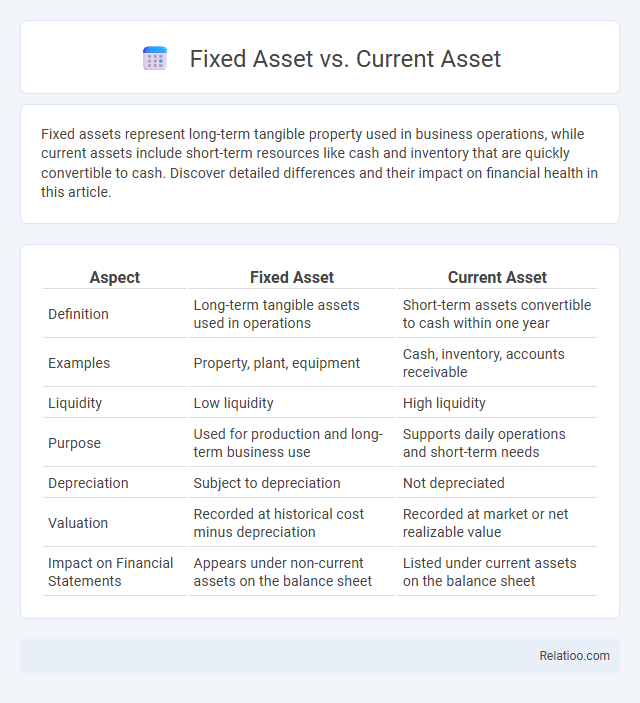Fixed assets represent long-term tangible property used in business operations, while current assets include short-term resources like cash and inventory that are quickly convertible to cash. Discover detailed differences and their impact on financial health in this article.
Table of Comparison
| Aspect | Fixed Asset | Current Asset |
|---|---|---|
| Definition | Long-term tangible assets used in operations | Short-term assets convertible to cash within one year |
| Examples | Property, plant, equipment | Cash, inventory, accounts receivable |
| Liquidity | Low liquidity | High liquidity |
| Purpose | Used for production and long-term business use | Supports daily operations and short-term needs |
| Depreciation | Subject to depreciation | Not depreciated |
| Valuation | Recorded at historical cost minus depreciation | Recorded at market or net realizable value |
| Impact on Financial Statements | Appears under non-current assets on the balance sheet | Listed under current assets on the balance sheet |
Introduction to Fixed and Current Assets
Fixed assets are long-term tangible property, such as machinery, buildings, and land, used in business operations to generate revenue over several years. Current assets include cash, inventory, and accounts receivable, which are expected to be converted into cash or used up within one fiscal year. Understanding the distinction helps you manage your company's resources effectively and optimize financial planning.
Definition of Fixed Assets
Fixed assets are long-term tangible assets such as buildings, machinery, and equipment used in the production of goods and services, not intended for immediate sale. Current assets include cash, inventory, and receivables expected to be converted to cash within one year. Assets broadly encompass all resources owned by a company that have economic value, classified into fixed and current assets based on their usage and liquidity.
Definition of Current Assets
Current assets are short-term resources expected to be converted into cash, sold, or consumed within one fiscal year, including cash, accounts receivable, inventory, and marketable securities. Fixed assets, also known as non-current assets, are long-term tangible property such as buildings, machinery, and equipment used in business operations for more than one year. The broader term asset encompasses both current and fixed assets, representing all resources owned by a company that hold economic value.
Key Differences Between Fixed and Current Assets
Fixed assets are long-term tangible assets like buildings, machinery, and equipment used in business operations, while current assets include cash, inventory, and accounts receivable expected to be converted into cash within one year. The key difference lies in liquidity; fixed assets are not easily liquidated and are subject to depreciation, whereas current assets are highly liquid and used for short-term financial needs. Understanding this distinction is vital for accurate financial analysis, asset management, and liquidity assessment.
Importance of Asset Classification in Accounting
Asset classification in accounting distinguishes fixed assets, current assets, and general assets to ensure accurate financial reporting and efficient resource management. Fixed assets, such as property and equipment, provide long-term value and depreciation tracking, while current assets, including cash and inventory, affect liquidity and operational capacity. Understanding this classification helps you analyze financial health and make informed decisions regarding asset utilization and investment strategies.
Examples of Fixed Assets
Fixed assets include tangible items like buildings, machinery, and vehicles that a company uses long-term to generate revenue. Current assets, such as cash, accounts receivable, and inventory, are expected to be converted into cash or used up within a year. Understanding these distinctions helps you manage your company's financial health and asset allocation effectively.
Examples of Current Assets
Current assets include cash, accounts receivable, inventory, and short-term investments, which are expected to be converted into cash within one year. Fixed assets consist of long-term tangible items such as machinery, buildings, and land, used in business operations and not easily liquidated. The broader category of assets encompasses both current and fixed assets, representing resources owned by a company that have economic value.
Impact on Financial Statements
Fixed assets, such as property, plant, and equipment, are recorded on the balance sheet as long-term assets and are depreciated over their useful life, impacting both the balance sheet and income statement through depreciation expense. Current assets, including cash, inventory, and receivables, appear on the balance sheet and affect liquidity ratios, playing a crucial role in the company's working capital management. The classification between fixed and current assets influences financial statement analysis by highlighting asset liquidity, depreciation effects, and overall financial health.
Asset Management Strategies
Fixed assets, such as property, plant, and equipment, require long-term management strategies focused on depreciation tracking, maintenance scheduling, and utilization optimization to maximize value over time. Current assets, including cash, inventory, and receivables, demand active management to ensure liquidity and operational efficiency while supporting short-term financial goals. Effective asset management strategies integrate both fixed and current assets, providing comprehensive oversight that aligns with Your organization's financial objectives and operational needs.
Conclusion: Choosing the Right Asset Mix
Selecting the right asset mix involves evaluating the balance between fixed assets, which provide long-term value like property and equipment, and current assets, such as cash and inventory, that support daily operations and liquidity. Your business's financial stability and growth potential depend on aligning asset types with operational needs and investment strategies. Understanding the distinctions ensures optimal resource allocation and maximizes overall asset efficiency.

Infographic: Fixed Asset vs Current Asset
 relatioo.com
relatioo.com